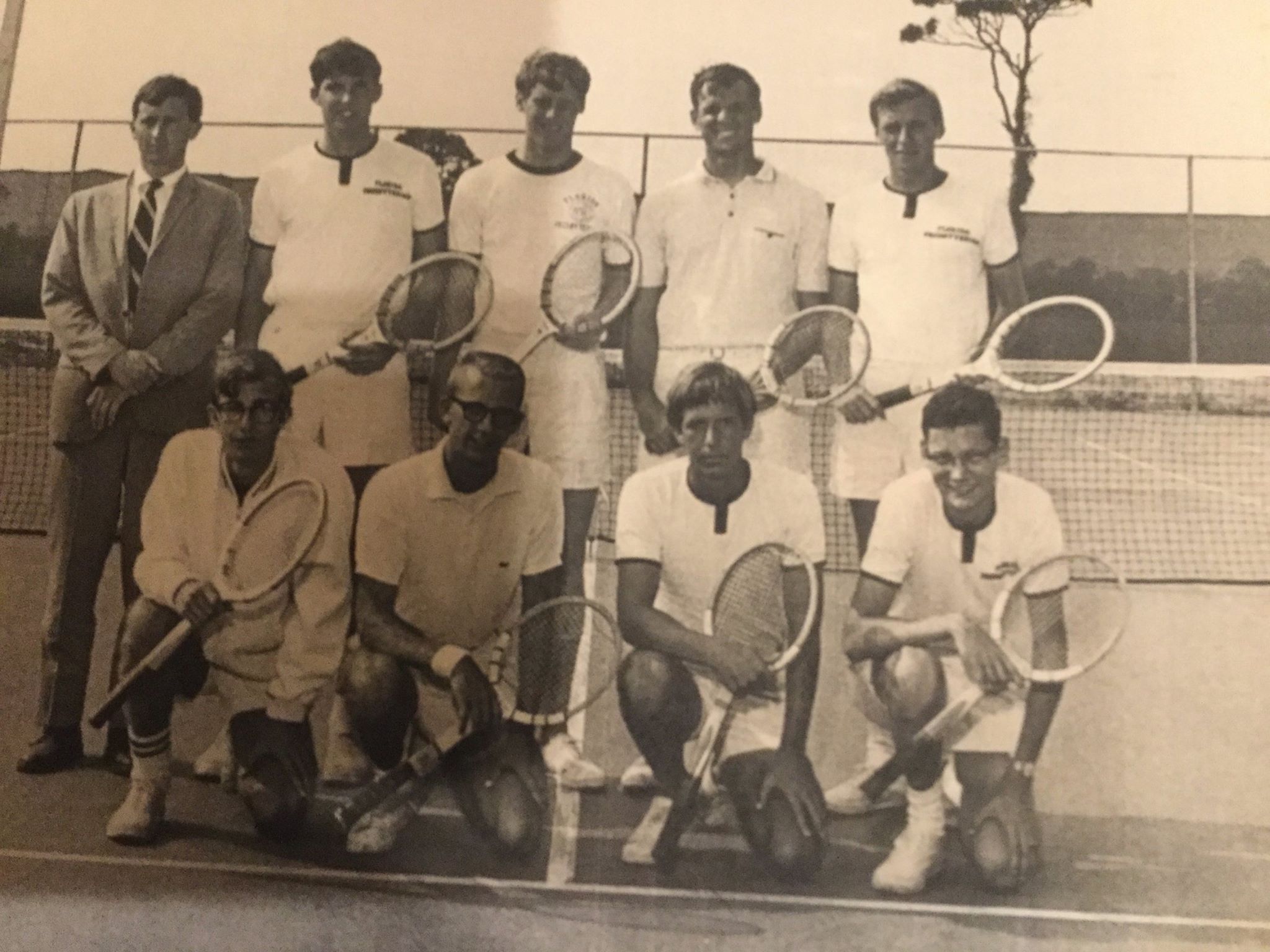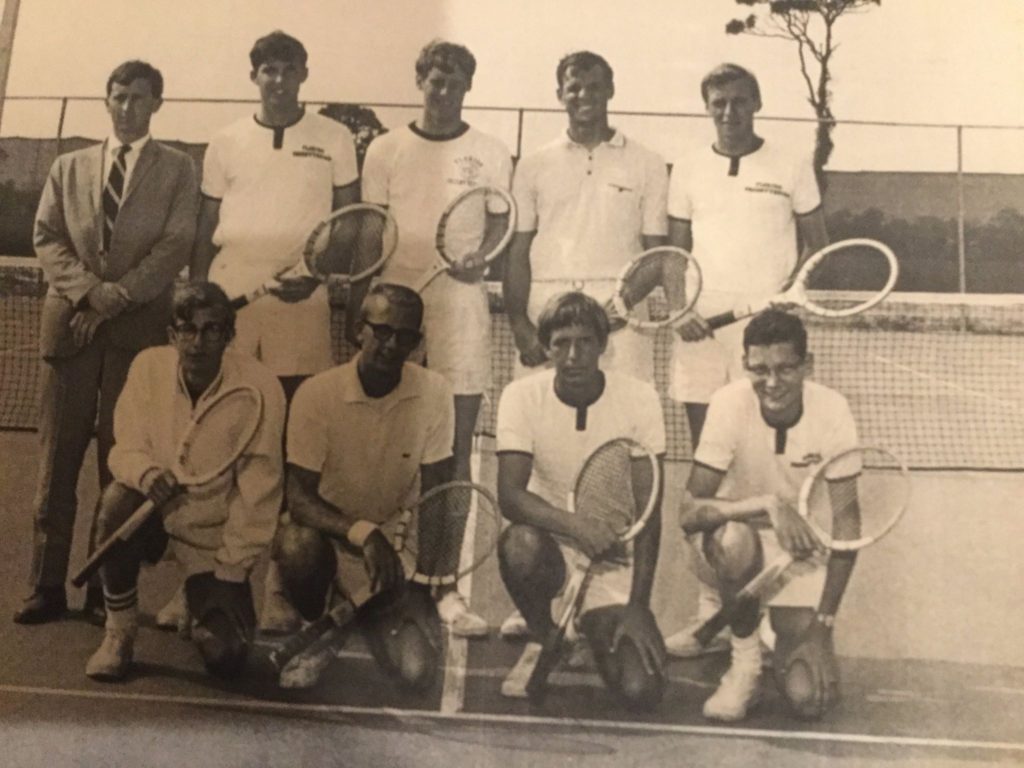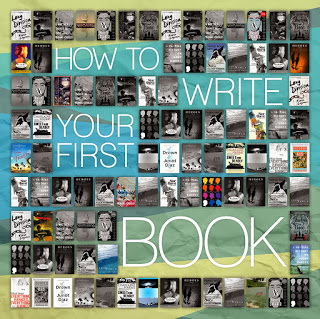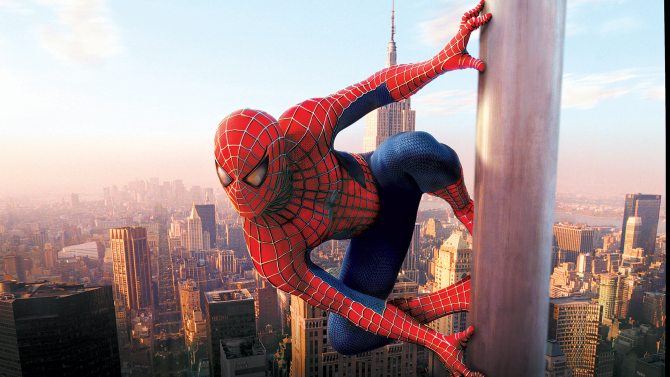
(The Florida Presbyterian College tennis team, 1968. That’s me, kneeling, second from right. With hair.)
I started playing tennis in the early Sixties on a pitted asphalt court next to the basketball gym in Hopkinsville, Kentucky. My buddy Bryan Lesueur and I started batting balls around one summer without any idea about how to play the game. We didn’t even know how to keep score. But we liked the feel of swatting those balls, even though as the summer sun melted the tar that someone had unwisely used to cover the pitted surface of the court, the warm tar turned the white balls black and our hands black and our clothes black.
Whoever designed and constructed that court must have consulted the Encyclopedia to get the dimensions and followed them without any idea what a real tennis court looked like. The asphalt underneath that layer of tar halted abruptly at the baseline. So there was a two or three inch drop off behind the baseline. The backcourt consisted of cinders, coal chips, which also were used to cover the running track that circled the football field.
So running around behind the baseline atop that thick layer of cinders was often treacherous. You also stood in cinders to serve, then stepped up onto the court to play, or you stayed back behind the baseline at the mercy of those slippery cinders. If nothing else those ridiculous challenges taught me nimble footwork.
Somehow Bryan and I came into possession of a copy of World Tennis magazine, a single copy that featured the stars of the time, Rod Laver, Ken Rosewall, Pancho Gonzalez, among others. We studied the photographs endlessly, totally unaware that most of the photos were selected because they featured a player in some dramatic and often extreme lunge or diving stab at a ball. We therefore came to believe that this was how tennis was supposed to look: a lot of flailing and thrashing and floundering. Quite the opposite of the elegant, graceful moves and smooth strokes that were the reality.
This was way before the tennis boom. This was long before there was even the smallest smidgen of tennis on television. We had nothing to go on. No models. Nothing but that single cherished copy of World Tennis.
We played and flailed and lunged summer after summer and through several falls and even played in heavy coats during the winter. I remember Bryan and I sweeping a layer of snow off the court more than once so we could whack some balls.
The coach Bryan and I had in high school knew no more about the game than we did. He was a baby-sitter who no doubt felt humiliation to be relegated to coaching tennis and not a real spring sport like track or baseball. We hardly saw him and I have no memory of his name.
So Bryan and I continued to fundamentally misunderstand the game, and only when my dad secured tickets to a tennis event in nearby Nashville we were lucky enough to see the barnstorming pros of that era play inside a basketball gym with a green tarp stretched over the court with a tennis court’s wonderful symmetric lines laid out on it, only then did we realize, upon seeing Laver, Rosewall and Gonzalez, that good tennis was a beautiful dance with pirouettes and arabesques and quickness and balance and a geometry of shot-making that was far superior to anything we ever imagined. (Laver broke three Dunlop Maxply rackets that night hitting backhand service returns.)
When later I went along with the high school team to regionals in Louisville, I encountered players my own age with skills so vastly superior to my own, it was a wonder I ever picked up a racket again. Kick serves, topspin, net play and drop shots and a level of athleticism that I’d had no idea existed at my age level.
In my senior year of high school, I played the number one position on my prep school tennis team. We played against other prep schools in Georgia, where my school, Riverside Military was located, and a few other southeastern schools. One away match was played in Tennessee at some other prep school whose name I forget. Their number one player, my opponent, was a mere ninth grader, while I was a senior. His name was Roscoe, a laughable moniker. Stepping on the court, I was certain I’d make short work of him. Turns out he was Roscoe Tanner who was to go on to be one of the best professional players of his generation (and a troubled soul). My hubris lasted only through the first few points. By then it became clear that my game did not exist in the same universe as his. He was bored immediately. I didn’t win a game, barely won a point. Still I played on.
My college tennis experience was similar. At the small liberal arts college in St. Petersburg, Florida I attended where there were no tennis scholarships, and the coaching was minimal, I again managed to become the number one player. We played against bigger Florida schools and once again I was reminded of my true station in the tennis universe.
I continue to play, to learn, to progress, to have moments of joy and humility. I can now watch tennis 24 hours a day on television and fantasize about how things might have turned out had I been lucky enough to have been born in a city or state where tennis was actually considered a real sport at that time. Oh, well. At least I don’t have to play on cinders anymore. And I did get one good poem out of the experience. This was published in Poetry magazine back in the mid-eighties, among the last poems I published as I transition from poet to novelist.
Tennis Elbow
From having fun
one way only,
doing the same thing,
the same way exactly,
grinding membranes
that once oiled
every movement,
that once made
the fluid glide
of bone on bone
the thud absorbed,
again absorbed,
until the thin pad
cushioning the heavy
parts of me from
the heavy parts of me
crumbles, disintegrates.
From years of grooving
the stroke: bounce-hit
bounce-hit, rehearse,
rehearse, racket back,
stroke, strike, follow
through. I know no
other way. The one trick
I know has worn thin
the cartilage,
has ground it down,
until it absorbs no more,
until I am in touch
with myself. Parts
never meant to touch
are touching. They touch
again, crush and grind,
until I am bright with ache.
And every winner I ever hit,
every exquisite triumph
has made me tender,
put a twinge in my step,
a shine in every act I do.




This is from my freshman year and I see our RA Bob Meacham (sp?) in the back row and I recognize the face, but not the name of the guy on the left end of the first row.
Bill (I think) Pettijon
I think you are correct.